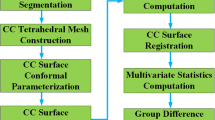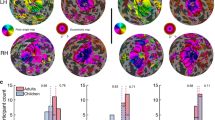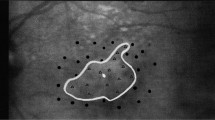Abstract
Blindness primarily induces structural alteration in the primary visual cortex (V1). Some studies have found that the early blind subjects had a thicker V1 compared to sighted controls, whereas late blind subjects showed no significant differences in the V1. This implies that the age of blindness onset may exert significant effects on the development of cortical thickness of the V1. However, no previous research used a trajectory of the age of blindness onset-related changes to investigate these effects. Here we explored this issue by mapping the cortical thickness trajectory of the V1 against the age of blindness onset using data from 99 blind individuals whose age of blindness onset ranged from birth to 34 years. We found that the cortical thickness of the V1 could be fitted well with a quadratic curve in both the left (F = 11.59, P = 3 × 10−5) and right hemispheres (F = 6.54, P = 2 × 10−3). Specifically, the cortical thickness of the V1 thinned rapidly during childhood and adolescence and did not change significantly thereafter. This trend was not observed in the primary auditory cortex (A1), primary motor cortex (M1), or primary somatosensory cortex (S1). These results provide evidence that an onset of blindness before adulthood significantly affects the cortical thickness of the V1 and suggest a critical period for cortical development of the human V1.



Similar content being viewed by others
References
Amedi, A., Raz, N., Pianka, P., Malach, R., & Zohary, E. (2003). Early ‘visual’ Cortex activation correlates with superior verbal memory performance in the blind. Nature Neuroscience, 6(7), 758–766. doi:10.1038/nn1072.
Anurova, I., Renier, L. A., De Volder, A. G., Carlson, S., & Rauschecker, J. P. (2015). Relationship between cortical thickness and functional activation in the early blind. Cerebral Cortex, 25(8), 2035–2048. doi:10.1093/cercor/bhu009.
Bengtsson, S. L., Nagy, Z., Skare, S., Forsman, L., Forssberg, H., & Ullen, F. (2005). Extensive piano practicing has regionally specific effects on white matter development. Nature Neuroscience, 8(9), 1148–1150. doi:10.1038/nn1516.
Benjamini, Y., & Hochberg, Y. (1995). Controlling the False Discovery Rate - a Practical and Powerful Approach to Multiple Testing. Journal of the Royal Statistical Society Series B-Methodological, 57(1), 289–300.
Bridge, H., Cowey, A., Ragge, N., & Watkins, K. (2009). Imaging studies in congenital anophthalmia reveal preservation of brain architecture in ‘visual’ cortex. Brain, 132, 3467–3480. doi:10.1093/brain/awp279.
Chung, M. K., Robbins, S. M., Dalton, K. M., Davidson, R. J., Alexander, A. L., & Evans, A. C. (2005). Cortical thickness analysis in autism with heat kernel smoothing. NeuroImage, 25(4), 1256–1265, doi:10.1016/j.neuroimage.2004.12.052.
de Brabander, J. M., Kramers, R. J., & Uylings, H. B. (1998). Layer-specific dendritic regression of pyramidal cells with ageing in the human prefrontal cortex. The European Journal of Neuroscience, 10(4), 1261–1269.
Fischl, B., & Dale, A. M. (2000). Measuring the thickness of the human cerebral cortex from magnetic resonance images. Proceedings of the National Academy of Sciences of the United States of America, 97(20), 11050–11055. doi:10.1073/pnas.200033797.
Fischl, B., Sereno, M. I., Tootell, R. B., & Dale, A. M. (1999). High-resolution intersubject averaging and a coordinate system for the cortical surface. Human Brain Mapping, 8(4), 272–284.
Fjell, A. M., Grydeland, H., Krogsrud, S. K., Amlien, I., Rohani, D. A., Ferschmann, L., et al. (2015). Development and aging of cortical thickness correspond to genetic organization patterns. Proceedings of the National Academy of Sciences of the United States of America, 112(50), 15462–15467. doi:10.1073/pnas.1508831112.
Gogtay, N., Giedd, J. N., Lusk, L., Hayashi, K. M., Greenstein, D., Vaituzis, A. C., et al. (2004). Dynamic mapping of human cortical development during childhood through early adulthood. Proceedings of the National Academy of Sciences of the United States of America, 101(21), 8174–8179. doi:10.1073/pnas.0402680101.
Gordon, J. A., & Stryker, M. P. (1996). Experience-dependent plasticity of binocular responses in the primary visual cortex of the mouse. Journal of Neuroscience, 16(10), 3274–3286.
Hubel, D. H., & Wiesel, T. N. (1970). The period of susceptibility to the physiological effects of unilateral eye closure in kittens. The Journal of Physiology, 206(2), 419–436.
Huttenlocher, P. R., & de Courten, C. (1987). The development of synapses in striate cortex of man. Human Neurobiology, 6(1), 1–9.
Jiang, J., Zhu, W., Shi, F., Liu, Y., Li, J., Qin, W., et al. (2009). Thick visual cortex in the early blind. The Journal of Neuroscience, 29(7), 2205–2211. doi:10.1523/JNEUROSCI.5451-08.2009.
Kupers, R., Pietrini, P., Ricciardi, E., & Ptito, M. (2011). The nature of consciousness in the visually deprived brain. Frontiers in Psychology, 2, 19. doi:10.3389/fpsyg.2011.00019.
Leopold, D. A. (2012). Primary visual cortex: awareness and blindsight. Annual Review of Neuroscience, 35, 91–109. doi:10.1146/annurev-neuro-062111-150356.
Lepore, N., Voss, P., Lepore, F., Chou, Y. Y., Fortin, M., Gougoux, F., et al. (2010). Brain structure changes visualized in early- and late-onset blind subjects. NeuroImage, 49(1), 134–140. doi:10.1016/j.neuroimage.2009.07.048.
Lerch, J. P., & Evans, A. C. (2005). Cortical thickness analysis examined through power analysis and a population simulation. NeuroImage, 24(1), 163–173. doi:10.1016/j.neuroimage.2004.07.045.
Li, J. J., Liu, Y., Qin, W., Jiang, J. F., Qiu, Z. X., Xu, J. C., et al. (2013). Age of onset of blindness affects brain anatomical networks constructed using diffusion tensor Tractography. Cerebral Cortex, 23(3), 542–551. doi:10.1093/cercor/bhs034.
Lorenz, K. (1935). Der Kumpan in der Umwelt des Vogels. Journal für Ornithologie, 83(2), 137–213.
Park, H. J., Lee, J. D., Kim, E. Y., Park, B., Oh, M. K., Lee, S., et al. (2009). Morphological alterations in the congenital blind based on the analysis of cortical thickness and surface area. NeuroImage, 47(1), 98–106. doi:10.1016/j.neuroimage.2009.03.076.
Petanjek, Z., Judas, M., Simic, G., Rasin, M. R., Uylings, H. B. M., Rakic, P., et al. (2011). Extraordinary neoteny of synaptic spines in the human prefrontal cortex. Proceedings of the National Academy of Sciences of the United States of America, 108(32), 13281–13286. doi:10.1073/pnas.1105108108.
Ptito, M., Schneider, F. C. G., Paulson, O. B., & Kupers, R. (2008). Alterations of the visual pathways in congenital blindness. Experimental Brain Research, 187(1), 41–49. doi:10.1007/s00221-008-1273-4.
Raznahan, A., Shaw, P., Lalonde, F., Stockman, M., Wallace, G. L., Greenstein, D., et al. (2011). How Does Your Cortex Grow? Journal of Neuroscience, 31(19), 7174–7177. doi:10.1523/Jneurosci.0054-11.2011.
Roder, B., Teder-Salejarvi, W., Sterr, A., Rosler, F., Hillyard, S. A., & Neville, H. J. (1999). Improved auditory spatial tuning in blind humans. Nature, 400(6740), 162–166. doi:10.1038/22106.
Sadato, N., PascualLeone, A., Grafman, J., Ibanez, V., Deiber, M. P., Dold, G., et al. (1996). Activation of the primary visual cortex by Braille reading in blind subjects. Nature, 380(6574), 526–528, doi:10.1038/380526a0.
Sadato, N., Okada, T., Honda, M., & Yonekura, Y. (2002). Critical period for cross-modal plasticity in blind humans: a functional MRI study. NeuroImage, 16(2), 389–400. doi:10.1006/nimg.2002.1111.
Schiller, P. H. (2010). Parallel information processing channels created in the retina. Proceedings of the National Academy of Sciences of the United States of America, 107(40), 17087–17094. doi:10.1073/pnas.1011782107.
Sowell, E. R., Peterson, B. S., Thompson, P. M., Welcome, S. E., Henkenius, A. L., & Toga, A. W. (2003). Mapping cortical change across the human life span. Nature Neuroscience, 6(3), 309–315. doi:10.1038/nn1008.
Striem-Amit, E., Ovadia-Caro, S., Caramazza, A., Margulies, D. S., Villringer, A., & Amedi, A. (2015). Functional connectivity of visual cortex in the blind follows retinotopic organization principles. Brain, 138(Pt 6), 1679–1695, doi:10.1093/brain/awv083.
Tong, F. (2003). Primary visual cortex and visual awareness. Nature Reviews Neuroscience, 4(3), 219–229. doi:10.1038/nrn1055.
Veraart, C., Devolder, A. G., Wanetdefalque, M. C., Bol, A., Michel, C., & Goffinet, A. M. (1990). Glucose-Utilization in Human Visual-Cortex Is Abnormally Elevated in Blindness of Early Onset but Decreased in Blindness of Late Onset. Brain Research, 510(1), 115–121. doi:10.1016/0006-8993(90)90735-T.
Voss, P., & Zatorre, R. J. (2012). Occipital cortical thickness predicts performance on pitch and musical tasks in blind individuals. Cerebral Cortex, 22(11), 2455–2465. doi:10.1093/cercor/bhr311.
Wang, D. W., Qin, W., Liu, Y., Zhang, Y. T., Jiang, T. Z., & Yu, C. S. (2013). Altered white matter integrity in the congenital and late blind people. Neural Plasticity. doi:10.1155/2013/128236.
Wierenga, L. M., Langen, M., Oranje, B., & Durston, S. (2014). Unique developmental trajectories of cortical thickness and surface area. NeuroImage, 87, 120–126. doi:10.1016/j.neuroimage.2013.11.010.
Acknowledgments
This work was supported in part by the National Key Basic Research and Development Program (973) (Grant 2011CB707800), the Strategic Priority Research Program of the Chinese Academy of Sciences (Grant XDB02030300) and the National Natural Science Foundation of China (Grant 91132301, 91432302, 81471380, 81101040). The authors thank Prof. Rhoda Perozzi and Prof. Edmund Perozzi for their considerable help in the manuscript preparation.
Author information
Authors and Affiliations
Corresponding author
Ethics declarations
Conflict of interest
The authors report no conflicts of interest.
Human studies
All procedures performed in studies involving human participants were in accordance with the ethical standards of the Ethics Committee of Tianjin Medical University and with the 1964 Helsinki declaration and its later amendments.
Informed consent
Informed consent was obtained from all the individual participants included in the study.
Additional information
Qiaojun Li and Ming Song contributed equally to this work and share the first authorship.
Electronic Supplementary Material
ESM 1
(DOC 106 kb)
Rights and permissions
About this article
Cite this article
Li, Q., Song, M., Xu, J. et al. Cortical thickness development of human primary visual cortex related to the age of blindness onset. Brain Imaging and Behavior 11, 1029–1036 (2017). https://doi.org/10.1007/s11682-016-9576-8
Published:
Issue Date:
DOI: https://doi.org/10.1007/s11682-016-9576-8




